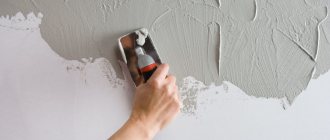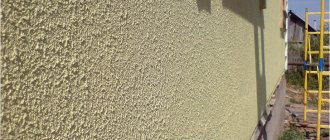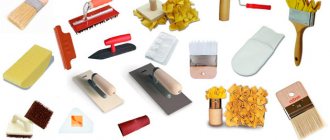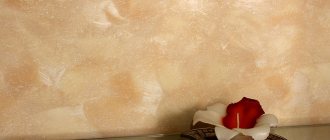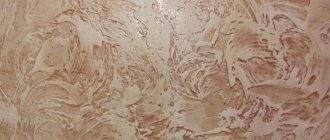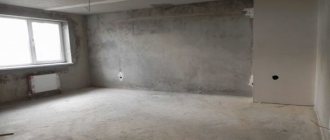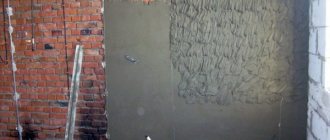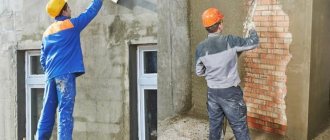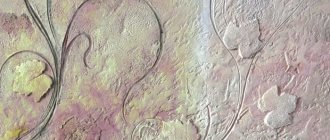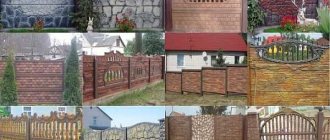Wall decoration with decorative plaster has gained popularity over the past 5 years. At the same time, applying decorative plaster is considered a complex process that cannot be done independently, and hiring a professional is expensive because the cost varies from 700 to 1,500 rubles. for 1m2. In fact, this is not so, all the work can be done without hiring hired specialists, and the result obtained will be no worse.
By choosing a decorative coating as a finishing material, you will give your home a unique design that will compare favorably with traditional renovation methods. Remember that, despite the beauty, this finish has its pros and cons.
The advantages include:
- Easy to clean;
- The design will be very impressive and 100% individual;
- The coating is durable;
- Requires minimal care;
- Not afraid of strong temperature changes;
- Some types of structural mortars act as an additional layer of insulation;
- Most materials are environmentally friendly;
- Some types of finishing will help hide the imperfections of the walls.
The disadvantages of using are:
- High cost (applies only to some mixtures);
- Some compositions require good preliminary preparation of the walls;
- Complexity of application compared to traditional repair methods;
- Lengthy and labor-intensive replacement process.
If these disadvantages are not critical, such repairs will be an excellent choice for both an apartment and a private house.
If you have no experience working with decorative materials yourself, it is recommended to practice beforehand. This can be done on pieces of drywall or plywood.
Types and methods of applying decorative plaster with your own hands.
Today, many types of decorative plaster are produced for wall decoration. Each of them has its own special options for applying plaster. But the surface preparation technology, the main part of the tool and the painting technology are the same.
To tell the reader how the technique of applying decorative coatings differs, let’s look at their main varieties.
Textured.
These decorative compositions include mixtures that give a unique relief on the wall when using a special tool (for example, structural rollers), the relief can also be obtained using special installation techniques (for example, decorative plaster world map). The movements of the master's hand in combination with the use of a special tool will create the desired patterns.
Structural.
For structural mixtures it is not necessary to use a special tool or special technique. An extraordinary relief is obtained due to the fillers included in the composition. Granite and marble chips, mineral inclusions, fibers of various fabrics and more are used as filler. Using a spatula and trowel, apply one layer to the surface, after the first layer has dried, use the trowel again to create a pattern. There are also marble plasters that create a stone shell of walls entirely consisting of particles of this noble stone.
Venetian.
This type of decorative plaster will give the house the real luxury of a Roman mansion. This wall covering imitates natural stone, most often marble, granite, malachite, etc. Before applying the composition, be sure to practice on sheets of drywall. The application process will be described separately because... is complex and a brief description will not be helpful.
Bas-relief
In the article, by bas-relief we will understand all types of sculptural images made using gypsum or other types of plaster and receding from the plane of the base to a short distance. Such work is carried out with subsequent decoration. If you feel the strength and talent to choose a bas-relief as a decoration, the efforts spent will be returned a hundredfold.
Choosing one of the listed types is difficult, but necessary, because the future method of application will depend on this choice.
Types of decorative plaster by material
Decorative plaster is used for design purposes.
The composition affects the technical and functional properties of the solution.
The main connecting component can be:
- silicate;
- mineral;
- silicone;
- acrylic.
Cellulose fibers, metallized threads, colors, pigments, crushed shells, etc. are often used as decorative additives. In addition, now additional substances are often introduced into the mixture to improve performance characteristics.
Mineral
This category includes types of plasters based on cement.
Additionally they may contain:
- clay;
- mineral chips;
- sandstone;
- lime, etc.
The basis of mineral plaster is cement.
Often, additives are added to the composition to give the finished coating a grainy appearance. Decorative plaster is sold in the form of a dry mixture, which can be stored in low humidity conditions for a long time. Ambient temperature is not important. The solution is prepared immediately before use. It can be applied not only with a trowel or spatula, but also with a hardware method. Often this type of material is used to eliminate uneven walls. Moreover, if the expected thickness of the decorative layer is more than 15–18 mm, a reinforcing mesh is used.
Mineral plaster is often used to imitate the surface of marble, granite, jade or other natural stones. There are many application methods to achieve different textures. The material is used for both external and internal work. With its help you can get both a smooth glossy and a rough matte surface.
The finished coating is characterized by moisture and frost resistance. Its main disadvantage is high porosity. It retains dust, lint particles, animal hair and other contaminants.
For cleaning you need to use special products. The finished surface is characterized by fire safety.
Acrylic
This category includes plasters based on acrylic resin. This component is highly elastic, so cracks rarely form on it. The composition can be applied either manually or mechanically. It adheres well to wood, OSB panels, brick, stone, drywall, foam and other porous surfaces.
Acrylic plaster is highly elastic.
To add color, a special pigment paste is added to the mixture. The material is sold in a state ready for application. It is packaged in large plastic buckets.
Acrylic plaster has many advantages:
- It dries quickly and tolerates sudden temperature changes.
- It can be used to decorate rooms with high humidity levels.
- It is allowed to include various additives in the mixture, incl. having antifungal and antiseptic effects.
- The acrylic coating does not absorb dirt and is easy to clean.
The service life of the material reaches 15 years.
At the same time, cracks may form on the plastered surface under the influence of ultraviolet radiation.
In addition, the material is characterized by low vapor permeability.
Silicone
The main binding component of plasters belonging to this category is silicone. The substance is made from resins, so it is characterized by high plasticity.
Silicone plaster is characterized by plasticity.
Plaster is used for interior and exterior work. It is characterized by high resistance to moisture, temperature changes, ultraviolet radiation, etc. An antifungal concentrate, fillers, stabilizers, pigment and other additives are often added to the composition. When applying, no preliminary leveling of the walls is required.
This type of finishing materials is characterized by a high level of vapor permeability, which helps maintain a normal microclimate in the room. Due to good elasticity, defects rarely appear on the finished surface due to mechanical stress. The recommended application tool is a spatula.
Silicate
This decorative material is made on the basis of liquid silicate glass. In addition, it contains additional mineral additives, pigments, etc. This plaster adheres reliably to many surfaces. The finished coating is characterized by high strength and wear resistance. Thanks to its silicate base, it withstands moisture and temperature changes well.
Silicate plaster repels dirt well.
A plastered wall repels many types of dirt. The material is non-flammable and resistant to cracking. It is often used for façade finishing and interior decoration.
Silicate composition is recommended for use when decorating kitchens and bathrooms.
Technology of applying decorative plaster to walls.
Now you know that application methods greatly depend on the choice of decorative plaster, but the general principles will be the same for all coatings. This part describes a simple procedure for applying all types of coatings to walls with your own hands.
The mixtures can be ready-made, dry or prepared independently. Depending on your desire, you can choose any of the above, the main thing is to strictly follow the manufacturer’s instructions when preparing and maintain all specified time intervals.
General technology step by step:
- Preparation. An important stage of work, regardless of the chosen mixture. Decorative finishing serves only to decorate the walls and is not intended to align them. Before proceeding to the main stage, level the wall using a cement-sand mixture. To ensure good adhesion, prime the surface. The only thing that requires perfect alignment of the walls is Venetian plaster.
- Application of material. The same stage that depends on the type of mixture. We will write in detail about the technology of laying the material in the following sections of the article.
- Preparing for coloring. Often, after finishing work, additional processing is required, such processing can be sanding, smoothing, etc. You need to sand, moving from coarse-grained to fine-grained sandpaper.
- Coloring . There are several ways to paint decorative plaster. Either this will be painting the mass of the material, or painting the surface. The choice of coloring method will depend on the desired effect. The material in bulk is colored by adding color.
- Finishing. Some coatings do not require such a stage, but types such as “Venetian” cannot do without additional treatment with wax or varnish. Wax is applied to add depth and shine to the stone's design. After application, do not forget about polishing.
From the above it is clearly seen that the volume and technology of work on applying decorative plaster are approximately the same, and will differ greatly only in relation to the coating formation process itself.
When carrying out repairs, do not neglect the safety rules! Use PPE (gloves, respirator, goggles, etc.). Use scaffolding or stepladders to work at heights.
Instructions for applying plaster
Applying plaster has its own subtleties. Taking them into account will help you avoid mistakes and get the highest quality finished coating without defects.
Preparing the walls
Before you start decorating the walls, you need to carefully prepare the base. The surface is cleaned of the old decorative layer. If there are places where the base plaster has peeled off or large cracks have appeared, they are cleaned and sealed.
Walls with a strong level difference are leveled with a cement-sand mixture. In this case, you need to wait until they dry. Then carefully treat the wall with a special primer. It will promote better adhesion of the plaster to the base and reduce the risk of the formation of fungal colonies on its surface. Often several layers of primer are applied, allowing each layer to dry. This increases the completion time of the work, but reduces the risk of peeling of heavy finishing material.
Application of flock plaster
People often choose flock plaster because... it does not require careful preparation of the base.
The application process includes 3 stages:
- First, the surface is treated with a thick layer of water-based acrylic adhesive.
- After this, flock plaster is applied. To do this, it is better to use a spray gun equipped with a compressor. Dry powder may fall onto the floor during operation. If necessary, it is collected and reused.
- Upon completion of treatment, the surface is allowed to dry for 6 hours.
- Then the flock mixture that has not stuck to the base is brushed off with a soft broom.
Applying plaster requires careful preparation.
The last stage is coating with protective varnish. To do this, you can use a soft roller or brush. The varnish will protect the surface from dust and damage.
Venetian plaster
Applying the “Venetian” is a rather complex process. This material fits well only on a previously prepared and leveled surface. It hardly hides defects. The “Venetian” is applied already tinted, in 2 layers. You should not mix a large portion of the solution at once to prevent it from drying out prematurely.
To fix the first layer, use a special spatula. You should put a little solution on it, and then apply it to the surface to be treated at an angle of approximately 30°. Subsequently, the “Venetian” is applied to the wall or ceiling with multidirectional strokes. It is desirable that each new portion lies perpendicular to the previous one. The layer thickness should not exceed 1–1.5 mm. After the material begins to harden, its surface should be polished. This will result in the formation of fine veins that are characteristic of marble.
The first layer should be left to dry for 24 hours. Then use a spatula to remove roughness and unevenness. After this, you can begin applying the second layer. The process is no different from the formation of the first one. If necessary, apply a third one in the future.
To create a more pronounced design, white, brown and black paints are often used.
Preparing the wall surface.
Let us briefly dwell on this stage of work as preparing walls for decorative plaster. Beginning craftsmen often wonder whether it is necessary to level the surface to perfection?
Like wallpaper, decorative plaster can be applied to uneven walls, but with some restrictions. For example, coatings requiring gloss should be applied to perfectly flat areas. Otherwise, after glossing, all irregularities (depressions, protrusions, differences) will become visible. Most of the solutions do not require special preparation, and on the contrary, textured and structural ones will help hide minor imperfections.
If you do not have the desire or ability to level the walls to an ideal state, in any case, the main thing is to properly prepare the surface before application.
For any finish the algorithm will be the same:
- Remove old plaster (especially if it is peeling).
- Repair cracks and scratches;
- Perform a rough finish - just plaster with a cement-sand mixture until strong visible defects are eliminated;
- Cleaning and dust removal are mandatory;
- Application of deep penetration primer.
As you can see from the above, the process described above is not complicated, and anyone can do it.
What you need to apply decorative plaster yourself.
In addition to the mixture itself, plastering requires a tool, and it will differ from the standard one. Like the technology, the equipment will change depending on the type of wall covering chosen.
Ordinary spatulas will not work, firstly, they have sharp edges, and secondly, they metalize the surface.
Let's list the required tool:
- Spatulas for decorative plaster have rounded edges and are made of high-quality metal.
- Trowels. Often special trowels are even called Venetian.
- Sponges for creating textures.
- Brushes for creating custom designs
- Special structural rollers
- How to paint the plaster is up to you. You can paint by adding a regular color to the base mass, or you can paint the already applied layer; for this, a sponge or brush will be enough.
Special tools are not cheap, but you will need them.
Accessories:
- Cotton gloves;
- Respirator;
- Fabric to protect floors and walls from dust and construction debris;
- Buckets;
- Stepladder for working at height;
Having learned the general principles, you can move on to discussing detailed application technology.
Advantages and disadvantages of decorative plaster
Plaster for interior work has many advantages over other types of finishing.
This material:
- provides additional sound insulation;
- durable and has a long service life;
- hides minor wall defects;
- can be used to create various decorative effects;
- not damaged by wet cleaning;
- helps maintain a normal indoor microclimate;
- resistant to temperature changes and moisture;
- characterized by high decorativeness, etc.
Interior plaster provides sound insulation.
At the same time, this decorative coating also has some disadvantages. These include the high cost of the material, the need for fairly thorough preparation of the base and the complexity of application.
It often takes several days for the premises to be decorated. In addition, it is worth considering that removing hardened plaster is quite difficult.
How to apply textured plaster.
Correctly applying decorative plaster to walls is not difficult, especially when it comes to textured mixtures. Let us remind you that textured or embossed mixtures are called mixtures whose pattern is created using special tools. To create an original relief, improvised materials are often used, such as: cellophane bags, wrapping paper, newspapers and much more.
Application steps:
- Preparation . Textured plasters are precisely those mixtures that do not require very careful leveling of the walls. It is enough to remove severe surface defects.
- Application. Using the textured mixture is very simple. As a rule, it is applied in a thicker layer compared to other types of coatings. Use a spatula and trowel to apply.
- Relief creation . Patterns are created with different tools.
Here are examples of such patterns obtained with different tools:
Canvas drawing - created with a hard brush, drawing first vertical and then horizontal lines, you will get a real artistic canvas.
Circular pattern - created by the same brush by rotating around an axis; waves or circles of different diameters also look good
Patterns with a roller – various patterns can be obtained using special structural rollers. You need to choose a roller with a pattern you like in the store and simply roll it along the wall. This way you can even get the texture of natural reptile skin.
Spraying is the simplest method. The first layer is applied evenly. The second step is to take a broom and dip it into the plaster, at this time you should have a stick in your other hand. By hitting a broom with a stick, we get a relief of various splashes on the wall. You can paint the first layer in any color, and spray it with another or even several colors.
- Leveling the formed coating. Often, after processing with a tool, parts of the relief that are too protruding remain; to remove such marks, use a trowel to smooth the slightly dried coating.
- Coloring. You can paint in one or two stages. You need to paint with a roller or sponge, this way the tops of the relief are made lighter, giving visual depth.
As you can see, do-it-yourself decorative plaster on walls is applied in just 5 simple steps.
Compliance with the correct sequence and accuracy in work guarantees a good result.
"Bark beetle."
Plaster imitating wood destroyed by the larvae of the beetle.
One of the easiest to implement.
How to apply decorative bark beetle plaster.
To create the coating, special mixtures with marble filler are used. You can prepare a similar solution yourself. It is enough to add marble granules to the usual mixture. It is advisable to use polished, round stones.
Decorative plaster is applied using regular casting. When leveling the layer with a grater, the pebbles are carried along with the tool and roll, leaving deep grooves.
When creating a coating, it is important to monitor the direction of movement of the tool. This affects the structure of the drawing and its direction.
“Bark beetle” is a decorative plaster, and the technology for its application is designed for finishing, and not for leveling chips, slopes and cracks.
The bark beetle does not require additional polishing with wax.
How to apply structural decorative plaster to walls with your own hands.
Decorating the outside of a house with various decorative plasters that have a structure is very common. The most famous of the mixtures of this type are “bark beetle” and sand plaster. Structural plaster is a composition with a mineral filler. Which are chips of marble, granite and much more. It is thanks to this filler that the structure is formed. Let's figure out step by step how to work with such coatings.
Application steps:
- Preparation. As with textured plaster, no special preparation is required; it is enough to remove significant damage and differences. Decorative bark beetle coating looks great as an exterior decoration for private houses. Don't forget to clean the walls of old coating, dust and dirt. Before plastering, the surface must be primed.
- Application. Apply the composition in an even layer on the walls, using a spatula and trowel for application.
- Second stage of application. Wait until the first layer dries and use a plastic spatula to begin smoothing the plaster using top-to-bottom movements. An individual pattern in the form of traces of a bark beetle will begin to appear on the surface. This pattern appears precisely due to the presence of large mineral granules in the composition.
- Coloring. The coloring of the structural mixture occurs by adding tint (color pigment). You can take the most common color scheme; in the store, the seller will definitely advise which option is right for you. No separate painting is required.
- Finishing. Some manufacturers recommend using additional wax to impart water-repellent properties.
Apply the plaster in sections. Start applying the next section strictly before the previous one has dried.
Decorative plaster by type of finish
Plasters are divided into types depending on texture. Their appearance is largely influenced by the additives and fillers included in the composition.
Textured
There are many options for such plaster. They contain additives that ensure the appearance of one or another texture after drying. A striking example is plaster with a craquelure effect. After drying, this coating becomes covered with large cracks. Often several layers of plaster of different colors are applied at once, and only the top one cracks.
When producing mixtures of textured plasters, manufacturers often use the following as a filler:
- small stone chips;
- shell;
- natural wood fibers;
- mica.
Textured plaster contains special additives.
Depending on the relief, the material can have a ready-made pattern, a random pattern, or an even coating with different color effects. Plaster is considered universal. It is applied to the already prepared surface in a layer of 0.2 to 2 mm.
Structural
It allows you to create a uniform surface with a particular pattern. To achieve this effect, small quartz grains and other mineral additives are added to the composition. Textured rollers are often used to create complex patterns.
Using this plaster, you can create artistic bas-reliefs of any complexity on the surface of the walls. Such compositions are well suited for the manufacture of three-dimensional panels and imitations of natural stone. Most types of structural plasters can be varnished and painted. This enhances the decorative effect. To add shine to the coating, crushed polyester film is added to the material. Various painting tools are used to apply plaster.
Structural plaster creates a surface with a pattern.
Venetian
The “Venetian” contains fine-grained marble chips. It is quite difficult to decorate its surfaces. High-quality wall preparation is important. Differences of no more than 3 mm per 1 sq.m are allowed. In this case, the plaster is applied in a thin layer. Because of this, any defects in the base will be clearly visible.
For application, spatulas of different sizes and other tools are used. Thanks to its composition and special installation method, plaster allows you to create a coating that accurately imitates polished marble. To add shine, the “Venetian” is coated with wax or varnish. It cannot be painted, because... this leads to the loss of the original decorative effect.
Venetian plaster contains marble chips.
Flock
The material got its name due to the inclusion of colored acrylic flakes - flocks - in its composition. These fragments can have different sizes and shapes. Flock is more often used to imitate velor, suede, leather, etc., decorating walls, columns and ceilings. The surface is smooth but warm. In terms of tactile sensations, it is comparable to paper wallpaper.
This plaster is characterized by high vapor permeability and is therefore not exposed to mold and other microorganisms. Moisture-resistant mixtures are now on sale. They can even be used to decorate kitchens or other rooms where a short-term increase in air humidity levels is possible. Flock plaster is easy to apply and does not require particularly careful preparation of the base.
Flock plaster is not susceptible to mold.
"Bark beetle"
This type of finishing materials is more often used for exterior decoration, less often for interior decoration. It is sold both dry and ready-made. The material contains mineral granules with a diameter of up to 2 mm. When applied, they leave rough, deep marks on the surface of the coating, reminiscent of the passages made by a bark beetle. Thanks to this decorative effect, plaster got its name.
"Bark beetle" adheres well to concrete, stone, brick and plasterboard surfaces. The process of applying it is simple.
Bark beetle is rarely used for interior work.
The composition dries for a long time, so if necessary, the applied mixture can be adjusted.
"Lamb"
The main binding component of such plaster is cement. Additional elements present in the mixture include dolomite, marble, quartz, etc. In addition, additives are often introduced into the material to ensure the coating’s resistance to moisture, temperature changes and ultraviolet radiation.
"Lamb" is sold dry. It is rarely used for interior decoration. It is more suitable for decorating facades: for walls made of brick, plasterboard, cement, natural stone, etc. The application process is simple, but it is important to properly prepare the surface by thoroughly cleaning and priming it to reduce the risk of fungus formation. To form a decorative texture, a special grater is used.
“Lamb” plaster is suitable for decorating facades.
"Fur coat"
This is another type of plaster that is more often used for exterior decoration. It's easy to apply. To create a decorative effect, just use a roller. The basis of the mixture is cement and plasticizers. The material is sold both ready-made and in the form of a dry mixture.
The coating adheres well to any mineral base, incl. brick and natural stone. It can be applied either with a special roller or by machine. At the same time, it is extremely important to properly prepare the base by removing dust from it and strengthening the weakened areas with putty in advance. The “fur coat” can be dyed.
“Shuba” adheres well to brick and natural stone.
Application of Venetian plaster.
Venetian decorative plaster is most often used for interior wall decoration. Walls with such a coating look simply gorgeous, but applying such a finish is the most difficult and time-consuming.
It will not be possible to describe the entire process in detail in this article. Therefore, we will focus on the most important points. So, “Venetian” is a mixture that imitates natural marble. To make the coating look natural, decorative plaster is applied in several layers.
Application order:
- Preparation. The surface must be leveled very carefully, this will help to avoid the appearance of defects after finishing. Don't forget about applying primer.
- Preparation of the composition. You can prepare a mixture for Venetian plaster yourself, but in this review we will only talk about ready-made compositions sold in stores. To imitate marble, it is necessary to prepare a composition of several shades. Depending on the chosen marble color. We take the finished composition, mix thoroughly, and pour into 3-5 containers.
- We select different colors depending on what kind of marble we want to get.
- Add the color to the prepared containers and mix thoroughly until the desired shades are obtained.
It is important to correctly calculate the required amount of color to obtain the required shades. To avoid mistakes in color selection, add color gradually while mixing.
- First and second layer. Venetian plaster should be applied to the wall carefully and slowly. Using a spatula, we apply various shades to the Venetian trowel. There is more of the base color, the remaining colors are in the proportion in which they will be in the intended drawing. Apply the resulting mixture to the surface. We apply the first two layers without trying to draw the pattern perfectly. We make chaotic movements during the application process, unless a directed pattern is planned.
- Third layer . The third layer is applied in the same way as the previous ones, but we pay much more attention to the formation of the stone pattern. To apply the final layer, you need to take a smaller spatula. Such a tool will allow you to form small details of the stone pattern.
- Sanding and ironing. We treat the resulting surface with fine sandpaper, and then go over the surface with a spatula, lightly pressing it. This is necessary to compact the surface and give it its original shine.
- We draw the veins. Using the same color that was added earlier, using a brush we draw veins on the surface of the marble.
- Finish coating. It is produced by applying a layer of wax, which is then polished using a grinder with a polishing wheel.
Decorative plaster applied in this way in the living room or other rooms will be an excellent decoration for the house.
Instructions for painting plaster
There are several methods for painting a plastered surface. Each of them has some subtleties.
Plain coloring
This method is considered the simplest. To carry out the work, you can use a paint brush or roller. In addition, you need to prepare the entire volume of paint and varnish material necessary to cover the entire surface. After this, the composition is poured into the tray. It is better to have several rollers of different sizes to achieve uniform coloring of all areas. If it is necessary to apply 2 layers, it is important to wait at least 24 hours so that the first one has time to dry.
Several shades
This method is most often used for painting textured surfaces. First, it is coated with paint of a darker tone. Then you need to wait until this layer dries. Next, paint with a light-colored composition and grout the surface. This will help highlight the drawing.
Several shades are used for textured surfaces.
Dry brush
First, a uniform coloring is carried out. It is important that the layer is dry. After this, a new batch of paint is prepared, adding a smaller amount of color to it. The material should be 1–2 shades lighter. Then apply a second coat using a short-nap roller. A minimum amount of paint is applied to the instrument. In this case, only the protrusions of the texture will be painted.
Wash
This is another fairly simple way to decorate plastered surfaces. To form the background layer, waterproof paint of a lighter tone is used. There should be no untreated areas left on the surface. Then a layer of paint of a darker color is applied. You need to wait for it to dry.
After this, using sandpaper soaked in water or a hard sponge, carefully treat the surface. It is important that the first, lighter layer is not damaged during the work. Dark areas should remain only in depressions and recesses.
DIY bas-relief.
There are unusual ways of applying gypsum and decorative plaster. One of these methods can be considered the creation of relief panels and bas-reliefs. Such works of art will look great in any room giving your home a luxurious look.
The bas-relief does not have to be made from special plasters; ordinary plaster will suffice. The sequence of work for making the bas-relief will be as follows:
- Surface preparation. Often, separate niches are prepared in the walls, or the outline of the future work is highlighted using a frame. The place where the relief image is applied is prepared in accordance with the plan. The surface can be either smooth or textured.
- Drawing an image. Using a stencil or dimensional grid, transfer the relief design to the wall.
- Creating a bas-relief. Using palette knives (special sculptural spatulas of various sizes), a sculptural image is formed. The gypsum mixture is prepared in small portions because it hardens quickly. The consistency should most closely resemble soft plasticine.
- Grinding. The resulting relief is sanded using sandpapers of different grain sizes. Then they pass over the surface with a mixture having the consistency of sour cream, removing the shells that appeared during the grinding process.
- Coloring. Paint the surface with acrylic paints using a spray bottle. If necessary, varnish is used as a finishing touch.
It is convenient to use half a children's rubber ball as a container for preparing portions of gypsum plaster. Such containers are easy to clean from frozen residues.
Applying varnish
It is impossible without this final procedure. Covering the entire work with varnish is necessary for shine, brightness and richness of the entire finish. In addition, this also gives it additional protection. You should use a water-based varnish like Tikkurila or Alpina. We dilute it with water in equal proportions, so it will better penetrate inside the structure. Apply in two or three layers using a wide brush. From time to time we squeeze it out on the paint tray, we don’t want smudges, right? The varnish dries quite quickly, so you won't have to wait long between coats. The finished wall can be washed with a regular rag without any fear of damaging it.
